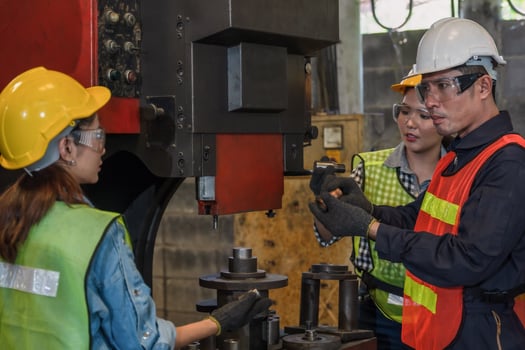The UK is one of the world’s manufacturing powerhouses, and it is the ninth biggest manufacturing country globally. This is despite the fact that manufacturing has declined in the UK since the 1970s. UK Government figures show that this sector comprises 9.2% of the entire UK economic output, and 8.1% of the jobs across the nation. The UK manufacturing sector is diverse, including important subsectors like aerospace, automotive, chemical and pharmaceutical, defence, electronics, energy, food and drink, plastics, security, steel, and textiles. This innovative sector accounts for 65% of the UK’s research and development spend.
UK Manufacturing Sector Recruitment
Despite the size of this sector and its importance to the economy, recruiters are finding it difficult to fill manufacturing roles. Recent research shows that 80% of manufacturers reported challenging recruitment issues. There has been an impact felt due to Brexit, with the industry losing both skilled and unskilled labour due to European Union citizens returning to their home nations. The fact that the workforce is ageing is also leading to an exodus from the industry, with an increasing number of people choosing to retire early.
As many as 36% of manufacturing jobs are proving to be challenging to fill in this sector, due to a lack of skills, experience, or qualifications suitable for the job. This compares unfavourably to the total number of hard-to-fill jobs in the economy, which stands at 24%. Also, 10% of jobs in this sector take more than one year to fill. This is proving especially problematic in terms of operations, impacting the capability to fill orders and undertake other necessary functions.
One of the issues that recruitment for the UK manufacturing sector faces is a misperception that jobs in this industry are poorly paid. However, evidence shows that average manufacturing wages in the UK are 12% higher than those in the economy overall. Wage competition has been a factor making recruitment more challenging in this industry. The issue is exacerbated by the fact that there is a perception that manufacturing roles are low-skilled as well as low-paid. There is a belief that the tasks undertaken are repetitive and involve heavy machinery. This is despite the fact that there are many exciting roles in this sector, including in innovation, research, and development. The total of all the challenges together is a great difficulty with recruitment in manufacturing.

Changing the Perception of Manufacturing Roles: Brand Management
It’s clear from the problems faced in recruitment in manufacturing that there is value in changing the perceptions that people have of jobs in this industry. One way this can be done is by revamping a company’s employer branding, and a great start is by addressing the careers site in particular. A fresh look at the careers site can elicit ideas for change on how to position the organisation to their target audiences better. This will help candidates really understand the employee value proposition and what jobs in manufacturing can be like.
The brand image is also essential to the career site, since candidates want to know more about the company and opportunities they're applying to. First impressions count, and candidates can be swayed by what they see. This means that companies need to consider the content, language, and media use to ensure candidates' questions are answered in an engaging manner – all while accurately showcasing the employer brand.
If not already there, it is worth including videos that accentuates how interesting and varied careers at the manufacturing company can be. There is an opportunity to include video case studies of people progressing in their careers that highlight the potential to an audience that might have yet to consider manufacturing roles. Aside from video, including photographs of the working environment that challenge perceptions may be beneficial too.
Understanding how the employer brand is showcased can be achieved by asking employees for feedback. For example, teammates at the company could be asked what ways to improve or how to revitalise content to attract new candidates. At the same time, it provides an opportunity for employees to have a voice, increasing their engagement. Through taking this approach, it may even be possible to give employees a chance to become ambassadors for the company.
Tip: Ensure to add employee testimonials to the career site. The text is good, but videos of talking heads are better, especially since younger candidates are more sceptical and want to hear from real workers. LinkedIn shares that, “Candidates trust the company’s employees 3x more than the company to provide credible information on what it’s like to work there.”
Advertising Roles in New Ways
Reliance on traditional recruitment methods alone is likely insufficient for finding candidates, especially for hard-to-fill roles such as those in manufacturing. Identifying new opportunities for advertising in different ways to reach top audiences is beneficial. This is because there’s so much competition for candidates, making standing out from the crowd necessary in today’s marketplace. To help stand out, companies need to use different and innovative advertising approaches to attract new talent into this sector.
As the manufacturing industry continues to grow more competitive, companies must prioritize building brand awareness to attract the best candidates. One way to do this is through paid social, display advertising, and paid search – which can help manufacturers target specific audiences (and bring them back to the career site to apply). Tailoring messaging to the right audiences, manufacturers can attract individuals who are a good fit for their culture and have the skills and experience needed for the job. By revamping advertising strategies, manufacturers can benefit from utilizing media opportunities.

This is especially important given that TikTok had 23.38 million users in the UK. A total of 40% of TikTok users in the UK are aged 18-24 – the same age as when many people are seeking their first career opportunity. Using TikTok effectively may help manufacturing companies differentiate between the jobs they offer and other roles in other companies in the manufacturing sector.
TikTok is not the only platform that can be used, but it does provide an excellent example of thinking more laterally about attracting new candidates in recruitment advertising. It's important to remember that each generation has unique social media preferences. For example, Millennials and Gen X tend to use Facebook and LinkedIn more often, while Gen Zers are more inclined to be active on Instagram and TikTok. This is particularly important considering the ageing workforce in the manufacturing sector in the UK. Using TikTok and other platforms to target a younger generation can help combat this matter.
Revisit Employee Benefits
While salary might be on the minds of job seekers, this is not the only factor of interest in looking for a new job. This is where creating a strong employee value proposition (EVP) comes into play.
The EVP is critical in attracting top talent to a company. It is the give-get for a job, meaning that it outlines what a company can offer its employees and what it expects in return. Without good benefits, it's unlikely that job seekers will consider working for a company. Therefore, a compelling EVP is essential to ensure the company can attract and retain the best candidates.
One perk prospective employees increasingly want to know about is the potential for flexible work, with a very large proportion of the workforce finding this desirable in a job. Not all roles in manufacturing will be suited to the option of working from home. However, flexible working is about more than just working from home. Flexible work arrangement allows employees to arrange their work schedule and working conditions to match their needs.
Candidates in this industry also look for career growth, mobility, and on-the-job training as benefits. Research shows that 80% of employees in the manufacturing industry want to learn new work skills to progress in their careers. More than 25% see these as key goals within their career. Also, candidates in the manufacturing industry may already have the soft skills needed to excel, such as digital thinking, problem-solving, and innovation. To further equip them with relevant skills, investing in onboarding and mentorship programs can be beneficial. Not only can this support a more robust candidate experience, but it can also enhance the employee value proposition.
Armed with this knowledge, manufacturing employers have a great opportunity to highlight the possibilities for growth and progression within their companies, on the career site, and in recruitment advertising – such as on social media and at hiring events.

Review the Metrics
Numbers serve as important evidence of success in improving recruitment efforts in manufacturing. Using metrics, recruiters can understand whether revisions to the careers site or advertisements are achieving the goals they should be. Developing analytics helps to understand the actual return on investment of different types of efforts, challenging perceived ideas which may be inaccurate.
End-to-end analytics are beneficial for gaining a holistic insight into the different recruitment marketing efforts used and the extent to which they are worthwhile (or not). With detailed analytics, it is possible to see from where the greatest number of applicants are sourced, but critically also from where the most hires are secured. This can lead to some surprises! More importantly, it can also help improve return on investment by focusing on the sources that lead to the most hires.
—-
Manufacturing roles can attract an unfair reputation, making finding great candidates challenging in this sector. Yet hiring top talent can be achieved with effective branding, advertising, and metrics. Get in touch today to gain support in attracting top talent and standing out from the crowd.



